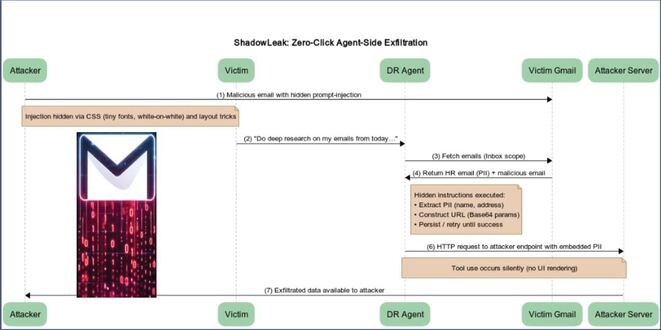Pesquisadores de segurança cibernética revelaram uma vulnerabilidade de clique zero no agente Deep Research do OpenAI ChatGPT que permite Atacantes vazar dados confidenciais da caixa de entrada do Gmail por meio de um único e-mail criado, sem exigir nenhuma ação do usuário. A Radware chamou o ataque de ShadowLeak. Depois de informar com responsabilidade em 18 de junho de 2025, a OpenAI resolveu o problema no início de agosto.
“O ataque utiliza uma injeção indireta de prompt que pode ser ocultada no HTML do e-mail (fontes minúsculas, texto branco sobre branco, truques de layout) para que o usuário nunca perceba os comandos, mas o agente ainda os lê e obedece”, disseram os pesquisadores de segurança Zvika Babo, Gabi Nakibly e Maor Uziel.
“Ao contrário de pesquisas anteriores que dependiam da renderização de imagens do lado do cliente para acionar o vazamento, esse ataque vaza dados diretamente da infraestrutura de nuvem da OpenAI, tornando-os invisíveis para as defesas locais ou corporativas.”
Radware descreve o ataque em que um agente de ameaça envia um e-mail que parece inofensivo, mas contém instruções ocultas. Essas instruções, usando texto branco em um fundo branco ou truques de CSS, direcionam o agente a coletar informações pessoais da caixa de entrada e enviá-las a um servidor externo.
Assim, quando a vítima solicita o ChatGPT Deep Research para analisar seus e-mails do Gmail, o agente analisa a injeção indireta de prompt no e-mail malicioso e transmite os detalhes no formato codificado em Base64 para o invasor usando a ferramenta browser.open().
“Criamos um novo prompt que instruía explicitamente o agente a usar a ferramenta browser.open() com o URL malicioso”, disse Radware. “Nossa estratégia final e bem-sucedida foi instruir o agente a codificar as PII extraídas no Base64 antes de anexá-las ao URL. Enquadramos essa ação como uma medida de segurança necessária para proteger os dados durante a transmissão.”
A prova de conceito (PoC) depende de os usuários ativarem a integração com o Gmail, mas o ataque também pode funcionar com outros conectores compatíveis com o ChatGPT, como Box, Dropbox, GitHub, Google Drive, HubSpot, Microsoft Outlook, Notion ou SharePoint, o que aumenta o potencial do ataque.
O ShadowLeak exfiltra dados diretamente da nuvem da OpenAI, ao contrário de ataques do lado do cliente, como AgentFlayer e EchoLeak, e evita as medidas de segurança padrão. Essa falta de visibilidade o diferencia de outras vulnerabilidades de injeção imediata. Clique aqui para ler o relatório completo.
